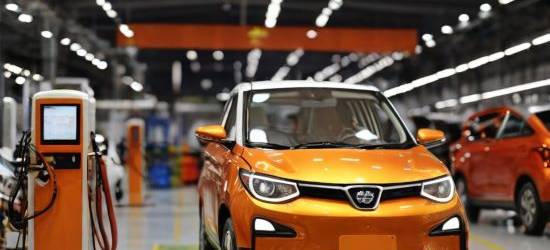India's eletric vehicle surge challenges traditional auto market dominance

By Team Indoen
Posted on 27 Mar 2024
The rise in demand for EVs (Electric Vehicles) has
detrimentally affected the market share of fuel-powered vehicles. The
sales of petrol vehicles, which were 86% of the market in 2020, saw a drop
compared with the preceding years and ended at 76% in 2023.
A Care Edge Ratings study showed a remarkable transformation
in the buying behaviour of automobile lovers, with the shifting trend from
conventional fuel vehicles to ones with alternative fuel sources.
The proportion of petrol vehicle sales, relative to the
total volume of vehicle sales, has exhibited a notable decrease, plummeting
from 86% in 2020 to 76% by 2023. Meanwhile, the share of diesel vehicle sales
has experienced a modest decline, slipping marginally from 12% in 2020 to 11%
in 2023.
In calendar year (CY) 2023, the sales volume of vehicles
powered by alternative fuels surged dramatically, experiencing a growth rate
exceeding 400% compared to CY 2020.
Currently, EVs and CNG cars are the most economically viable
transportation systems where EVs are on the top and CNG is a little
behind. The development of EV demand arises from the interaction of
various factors, for instance, government incentives, battery cost decreases,
and oil price increases. India has become a model to be followed by aiming
to sell 30% of all vehicles as EVs by the same year 2030.
To boost the development of charging stations, the government
has launched various programmes aimed at the inclusion of alternative fuel in
national infrastructure. One of the popular schemes includes subsidies and
grants, which are devised to support as well as to promote the building of
charging stations across the country.
Despite their higher initial investment, EVs emerge as a
financially advantageous choice over the long term, owing to their reduced fuel
and maintenance outlays. This, combined with governmental incentives, renders
them notably more cost-effective compared to conventional petrol and diesel
vehicles, particularly advantageous for drivers covering extensive mileage.
The allocation of Rs 1,500 crore dedicated to support the
FAST program under FAME-II is the latest news towards rewarding the usage of
EVs in India. The bolstered allocation and targeted approach of FAME-II
are anticipated to expedite EV adoption in India by March 2024, urging
potential buyers to capitalize on the opportunity before its depletion.
On March 15, in a move towards enhancing India's position as
a manufacturing powerhouse for EVs, the Union Government began a comprehensive
scheme aiming at attracting investments in the sector and promoting the indigenous
make of EVs with advanced technology.
Endorsed by the Ministry of Commerce and Industry, this
policy stands ready to transform the automotive sector within the nation,
creating an enabling atmosphere for esteemed international EV manufacturers to
establish their footprint in India.
The primary aim of the freshly sanctioned E-Vehicle Policy
is to streamline EV manufacturing within India, thereby granting Indian
consumers access to cutting-edge technology while reinforcing the Make in India
initiative.
Through incentivising investments in the EV sector, the policy aims to invigorate the entirety of the EV ecosystem, cultivating robust competition among industry stakeholders, boosting production capacities, achieving economies of scale, and ultimately reducing production costs.
Will China reap the benefit?
Meanwhile, a separate study published by the Global Trade
Research Initiative (GTRI) projects that the Indian government’s moves to
uplift indigenous EV manufacturing would bring in Chinese auto firms,
especially manufacturers of EVs and relative components. China’s automotive
industry which garners support from the Chinese government makes it a leading
exporter of EVs.
India’s auto component imports during 2022-23 which was US$
20.3 billion of which 30% came from China could increase significantly. China
since it exercises a larger control over the EV components’ global supply chain
can easily flood Indian markets with cheaper components.
Also, China has 75% of the world’s battery production
capacity. Battery accounts for 40% of the manufacturing cost of an EV. With
more than 50% of the global EV production and exports being its forte, China is
a significant player.
The GTRI report states that almost every third of EVs and
many passenger and commercial vehicles plying on Indian roads would be
Chinese-made. This could be the ones made by Chinese firms in India or through
a joint venture by Chinese and Indian firms.
Incidentally, last year Chinese auto major SAIC Motor entered into a joint venture agreement with JSW Group to transform and grow MG Motor in India and sell about one million EVs in India by 2030 when the market size is expected to be around 10 million units annually. This isn’t a one-off, more Chinese companies are waiting in the wings to sign pacts with Indian firms.
Image courtsey: Care Edge Rating
Kindly follow us on:
- India’s climate finance blueprint: A snail’s pace or a fast gallop?
- Strategic Pathways For India’s Green Mobility
- India’s green hydrogen mission: Powering a sustainable future
- India to cap investment in EV charging for tariff relief as Tesla entry...
- Centre likely to modify new EV policy as Tesla gears up to enter India
- India's EV push needs high-speed trains ... China's adoption rate
- India's EV incentive plan finds no takers-government weighs fix
- Why Tesla’s entry is unlikely to disrupt India’s retail EV market
- Scaling up e-mobility in India hinges on private investment and policy reforms, say experts
- India needs 39 lakh charging stations by 2030: report